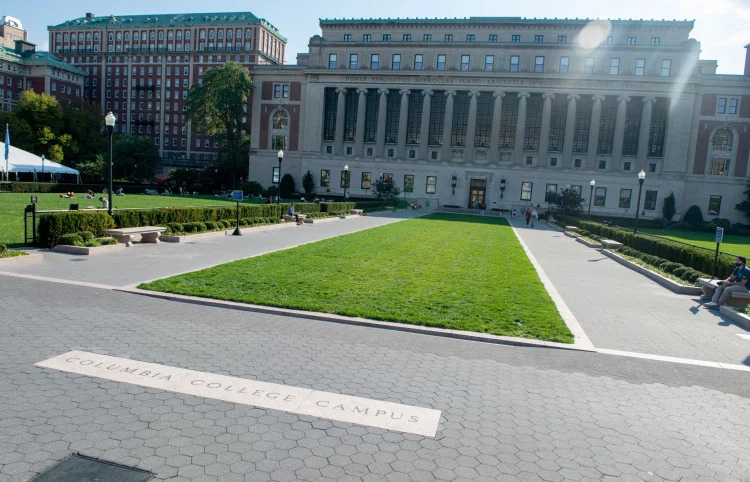哥倫比亞大學8成學生罷課,,親歷者講述原因

當前的大學生對他們所受教育的真正成本幾乎一無所知,。 1998年——在目前大多數(shù)本科生尚未出生之前,哥倫比亞大學(Columbia University)的學費為24,144美元,,相當于今天的38,582美元。而現(xiàn)在,這筆費用已經(jīng)激增至58,789美元,,讓哥倫比亞大學成為全美最昂貴的學校之一,。同時,,實際工資的增長已經(jīng)趨于平緩。因此,,在入學成本如此爆炸式般的增長下,,學生成為了最大的受害人,。目前,,哥倫比亞大學的畢業(yè)生平均背負著21,979美元的債務,。
哥倫比亞大學擁有110億美元的捐贈基金,足以為學生提供他們負擔得起的教育,。沒有人會覺得,,入學成本加倍會使教育質量也翻一番。相反,,哥倫比亞大學收取更多的費用,,是為了支付其擴校所需的65億美元——用來讓近3.2萬名西哈萊姆區(qū)的居民搬遷、給管理人員發(fā)放數(shù)百萬美元的薪水和奢侈的津貼,,以及打造一個過于豪華的公共安全部門,。
美國高等教育的矛盾在哥倫比亞大學集中爆發(fā)。然而,,在蕭墻之內,,哥倫比亞大學的學生正在反擊。超過4,000名學生(占所有本科生和研究生人數(shù)的八分之一)已經(jīng)聯(lián)署支持美國歷史上最大的學費罷課計劃,,目的是從根本上重新擺正大學的定位,,提醒它們作為“大學”,,應該將哪些事項放在首位,力求建立一個更加民主的機構,。學生誓稱將暫時不繳納自己的學費,,直到哥倫比亞大學將學費降低10%,,經(jīng)濟援助提高10%,解決校園和西哈萊姆地區(qū)歧視黑人的種族主義問題,,開始與研究生工會坦誠談判,,并向學生和社區(qū)提高投資決策的透明度,,加大對資金的管控力度,。
而重整大學與學生之間關系的愿景遠遠超出了哥倫比亞大學本身,。哥倫比亞大學只是推動學費爆炸式上漲趨勢的冰山一角,這種漲價的邏輯貫穿了整個高等教育界,。當哥倫比亞大學提高學費時,,其他大學也跟著做出同樣的舉動,。當哥倫比亞大學將這些資金投資于奢侈的新發(fā)展和炫耀性地展示自己的財富,、以吸引潛在的學生時,,哥倫比亞大學的競爭對手也紛紛效仿,。為了爭奪最優(yōu)秀、最聰明的美國青年,,高校正在進行一場投建豪華設施的軍備競賽,。然而,當高中生們被這些光鮮亮麗的事物誘惑后,進入大學的他們卻發(fā)現(xiàn),,和沉重的債務相比,,這些華而不實之物再無半點吸引力,。
當前的新冠疫情讓大學中核心的道德敗壞問題得到了極大的緩解,?;氐綕摬刂N種不穩(wěn)定因素的家中,,學生們常常坐在電腦前,,上著通常缺乏足夠經(jīng)費的教授的網(wǎng)課,。他們和他們的家人正在大蕭條(Great Depression)以來最大的經(jīng)濟衰退中掙扎,前景一片慘淡——失業(yè),、數(shù)十萬美元的學費債務、身兼數(shù)職以維持生計,,以及對失去資助的持續(xù)焦慮。顯然,,一定有哪里出了什么問題,。
事情也不是非要演變至此的,。哥倫比亞大學的罷課學生的想法來自另外一所大學的愿景——該大學將學生,、教職員工和周圍社區(qū)的利益置于各類“世界高校排名”和塞滿管理層的腰包之前,。要求學生支付幾乎與美國家庭收入中位數(shù)相當?shù)膶W費是荒謬的,,尤其是在世界上其他每個國家都能夠以很小一部分的成本來提供相同質量的教育產品的情況下,。(畢竟,哥倫比亞大學只是美國高等教育的痼疾中出現(xiàn)的最急性的癥狀之一,,感染了美國所有的高等教育,。)
哥倫比亞大學的管理層希望通過整個經(jīng)濟環(huán)境緊縮的邏輯來掩蓋這種荒謬。他們堅稱自己的手頭也很緊張,,因為大學的資金與捐贈基金的分配掛鉤,。他們“遺憾地告知”學生,即便他們可以滿足學生的需求,,但這也會以教師,、學生和普通員工的利益為代價。
然而,,這種邏輯根本不成立,。哥倫比亞大學賬面上有8.14億美元,還有另外37億美元專門用于支付“意外費用”,,例如新冠疫情全球大流行造成的后果,。普林斯頓大學,、喬治城大學和威廉姆斯大學等同等機構已經(jīng)在不犧牲教師、研究生或工人的情況下,,出于疫情減免了學費,。二十多年前的學生坐在同一張課桌前,接受同樣的教誨,,而要交的學費卻只是今天的一小部分,。
面對當前的危機,學生們識破了“經(jīng)濟緊縮”的謊言,。1月22日,,我們成千上萬的學生表示將拒絕支付春季學期的學費,并繼續(xù)保留這筆錢,,直到滿足我們的要求為止——我們已經(jīng)贏得了校方許多有意義的讓步——包括給一些學生提供緊急資助——但這遠遠不夠,。我們希望能夠贏得更多。一所嶄新的大學近在咫尺——現(xiàn)在,,學生正在抓住這個機會,。
湯森德?納爾遜是哥倫比亞大學的高年級學生,也是學費罷課的組織者之一,。(財富中文網(wǎng))
編譯:陳聰聰
當前的大學生對他們所受教育的真正成本幾乎一無所知,。 1998年——在目前大多數(shù)本科生尚未出生之前,哥倫比亞大學(Columbia University)的學費為24,144美元,,相當于今天的38,582美元,。而現(xiàn)在,這筆費用已經(jīng)激增至58,789美元,,讓哥倫比亞大學成為全美最昂貴的學校之一,。同時,實際工資的增長已經(jīng)趨于平緩,。因此,,在入學成本如此爆炸式般的增長下,學生成為了最大的受害人,。目前,,哥倫比亞大學的畢業(yè)生平均背負著21,979美元的債務。
哥倫比亞大學擁有110億美元的捐贈基金,,足以為學生提供他們負擔得起的教育,。沒有人會覺得,入學成本加倍會使教育質量也翻一番,。相反,,哥倫比亞大學收取更多的費用,是為了支付其擴校所需的65億美元——用來讓近3.2萬名西哈萊姆區(qū)的居民搬遷、給管理人員發(fā)放數(shù)百萬美元的薪水和奢侈的津貼,,以及打造一個過于豪華的公共安全部門,。
美國高等教育的矛盾在哥倫比亞大學集中爆發(fā)。然而,,在蕭墻之內,,哥倫比亞大學的學生正在反擊。超過4,000名學生(占所有本科生和研究生人數(shù)的八分之一)已經(jīng)聯(lián)署支持美國歷史上最大的學費罷課計劃,,目的是從根本上重新擺正大學的定位,,提醒它們作為“大學”,應該將哪些事項放在首位,,力求建立一個更加民主的機構,。學生誓稱將暫時不繳納自己的學費,直到哥倫比亞大學將學費降低10%,,經(jīng)濟援助提高10%,解決校園和西哈萊姆地區(qū)歧視黑人的種族主義問題,,開始與研究生工會坦誠談判,,并向學生和社區(qū)提高投資決策的透明度,加大對資金的管控力度,。
而重整大學與學生之間關系的愿景遠遠超出了哥倫比亞大學本身,。哥倫比亞大學只是推動學費爆炸式上漲趨勢的冰山一角,這種漲價的邏輯貫穿了整個高等教育界,。當哥倫比亞大學提高學費時,,其他大學也跟著做出同樣的舉動。當哥倫比亞大學將這些資金投資于奢侈的新發(fā)展和炫耀性地展示自己的財富,、以吸引潛在的學生時,,哥倫比亞大學的競爭對手也紛紛效仿。為了爭奪最優(yōu)秀,、最聰明的美國青年,,高校正在進行一場投建豪華設施的軍備競賽。然而,,當高中生們被這些光鮮亮麗的事物誘惑后,,進入大學的他們卻發(fā)現(xiàn),和沉重的債務相比,,這些華而不實之物再無半點吸引力,。
當前的新冠疫情讓大學中核心的道德敗壞問題得到了極大的緩解?;氐綕摬刂N種不穩(wěn)定因素的家中,,學生們常常坐在電腦前,上著通常缺乏足夠經(jīng)費的教授的網(wǎng)課。他們和他們的家人正在大蕭條(Great Depression)以來最大的經(jīng)濟衰退中掙扎,,前景一片慘淡——失業(yè),、數(shù)十萬美元的學費債務、身兼數(shù)職以維持生計,,以及對失去資助的持續(xù)焦慮,。顯然,一定有哪里出了什么問題,。
事情也不是非要演變至此的,。哥倫比亞大學的罷課學生的想法來自另外一所大學的愿景——該大學將學生、教職員工和周圍社區(qū)的利益置于各類“世界高校排名”和塞滿管理層的腰包之前,。要求學生支付幾乎與美國家庭收入中位數(shù)相當?shù)膶W費是荒謬的,,尤其是在世界上其他每個國家都能夠以很小一部分的成本來提供相同質量的教育產品的情況下。(畢竟,,哥倫比亞大學只是美國高等教育的痼疾中出現(xiàn)的最急性的癥狀之一,,感染了美國所有的高等教育。)
哥倫比亞大學的管理層希望通過整個經(jīng)濟環(huán)境緊縮的邏輯來掩蓋這種荒謬,。他們堅稱自己的手頭也很緊張,,因為大學的資金與捐贈基金的分配掛鉤。他們“遺憾地告知”學生,,即便他們可以滿足學生的需求,,但這也會以教師、學生和普通員工的利益為代價,。
然而,,這種邏輯根本不成立。哥倫比亞大學賬面上有8.14億美元,,還有另外37億美元專門用于支付“意外費用”,,例如新冠疫情全球大流行造成的后果。普林斯頓大學,、喬治城大學和威廉姆斯大學等同等機構已經(jīng)在不犧牲教師,、研究生或工人的情況下,出于疫情減免了學費,。二十多年前的學生坐在同一張課桌前,,接受同樣的教誨,而要交的學費卻只是今天的一小部分,。
面對當前的危機,,學生們識破了“經(jīng)濟緊縮”的謊言。1月22日,,我們成千上萬的學生表示將拒絕支付春季學期的學費,,并繼續(xù)保留這筆錢,直到滿足我們的要求為止——我們已經(jīng)贏得了校方許多有意義的讓步——包括給一些學生提供緊急資助——但這遠遠不夠。我們希望能夠贏得更多,。一所嶄新的大學近在咫尺——現(xiàn)在,,學生正在抓住這個機會。
湯森德?納爾遜是哥倫比亞大學的高年級學生,,也是學費罷課的組織者之一,。(財富中文網(wǎng))
編譯:陳聰聰
Current college students have little context for grasping the true cost of their education. In 1998, before most current undergraduates were born, tuition at Columbia University was $24,144, or $38,582 in today’s dollars. Now that cost has ballooned to $58,789, making Columbia one of the most expensive schools in the nation. Meanwhile, real wages have flatlined. Consequently, this explosion in the cost of attendance has hurt students the most; the average Columbia student currently graduates with $21,979 of debt.
Columbia has an $11 billion endowment, more than enough to provide students an affordable education. No one would argue that doubling the cost of attendance has doubled the quality of education. Instead, Columbia charges more in order to pay for a $6.5 billion expansion that will displace nearly 32,000 West Harlem residents, administrators’ multimillion-dollar salaries and extravagant perks, and a bloated public safety department.
Columbia is the nadir of America’s pathological relationship with higher education. Yet, from the belly of the beast, Columbia students are fighting back. More than 4,000 students, or an eighth of all graduates and undergraduates, have signed on in support of what would be one of the largest tuition strikes in this country’s history, aiming to radically reorient the university’s priorities to create a more democratic institution. Students pledge to withhold tuition until Columbia lowers tuition by 10% and increases financial aid by 10%, addresses anti-Black racism on campus and in West Harlem, begins to bargain in good faith with the graduate worker labor union, and provides students and the community greater transparency and control over investment decisions.
This vision of a new relationship between colleges and students stretches well beyond Columbia’s gates. Columbia, at the tip of the iceberg, drives an accelerationist logic of tuition increases that reverberates across higher education. When Columbia raises its tuition, other universities are given cover to do the same. When Columbia invests that money in glitzy new developments and ostentatious displays of wealth to attract prospective students, these competitors follow suit. In competing for the best and brightest American youth, colleges have created an arms race of luxury amenities. Yet the shiniest objects of desire for high school seniors lose their charm for debt-burdened college students.
The present pandemic has thrown into stark relief the moral rot at the heart of the collegiate racket. Returning to potentially precarious home situations, students spend their days sitting in front of their computers, taught by professors who often lack adequate financial support, as students and their families struggle with the largest economic downturn since the Great Depression. Student testimonials are bleak—lost jobs, hundreds of thousands of dollars of tuition debt, working multiple jobs to make ends meet, and constant anxiety about losing financial aid. It is obvious that something has gone terribly wrong.
It doesn’t have to be like this. Columbia strikers are inspired by a vision of a university that prioritizes students, faculty, and the surrounding community over U.S. News & World Report rankings and lining administrators’ pockets. It is absurd to be paying almost as much as the U.S. median household income for tuition, especially when every other country can provide the same product for a fraction of the cost. (Columbia is, after all, only one of the most acute symptoms of a disease infecting all of American higher education.)
Columbia’s administration hopes to conceal this absurdity by falling back on austerity logic. Insisting that their hands are tied in the allocation of endowment funds, they “regret to inform” students that even if they could meet students’ demands, it would come at the expense of faculty, graduate workers, and rank-and-file staff.
Yet this logic simply does not hold. Columbia has $814 million on hand—and another $3.7 billion in the bank—specifically for such “unexpected costs” as the fallout of a global pandemic. Peer institutions like Princeton, Georgetown, and Williams have already cut tuition in response to COVID without sacrificing faculty, graduate students, or workers. Two decades ago, students sat at the same desks as us, receiving the same instruction, at a fraction of the price.
Faced with the present crisis, students have realized the lie of “austerity.” On Jan. 22, thousands will refuse to pay tuition for the spring semester and will continue to withhold it until our demands are met. We have already won a number of meaningful, but insufficient, concessions, including emergency grants for some students. We fully expect to win more. A new university is within reach—now, students are grabbing hold of it.
Townesend Nelson is a senior at Columbia University and one of the organizers of the tuition strike.













